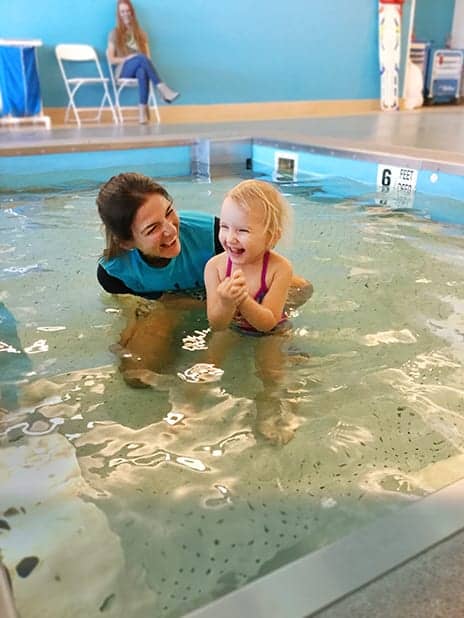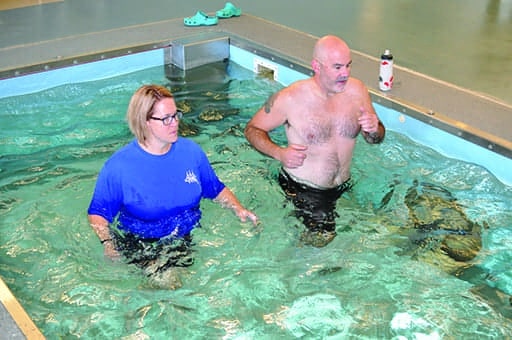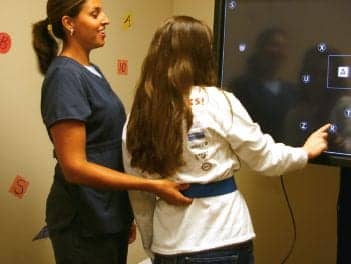
Zea, a 2-year-old with a history of Stage IV neuroblastoma resulting in paraplegia, works on improving her standing balance through play alongside Rachel Mertins, PT, DPT.
by Rachel Mertins, PT, DPT
Imagine waking up one morning with the inability to get yourself out of bed, to use the restroom independently, to eat breakfast without assistance, or to move around the community without strangers staring or avoiding you and your “disability.” This is the hard reality of many adults and children suffering from paralysis, which results in significant physical impairments and limits their optimal function and overall quality of life. Therapists and physicians in the healthcare field are dedicated to improving the lives of those with poor physical health by restoring function. Sometimes the building blocks of function are found in the element of water.
The aquatic setting “has profound biological effects, extending across essentially all homeostatic systems” which allow therapists to address a spectrum of acute lesions as well as chronic illness, but this modality remains largely underutilized in rehabilitation.1 In addition to the many benefits derived from the water, including buoyancy, viscosity, and hydrostatic pressure, which decreases the fear of falling and enhances balance confidence, the underwater treadmill provides repetitive and rhythmic stepping motion2 which stimulates the central pattern generator, improves inter-limb coordination, and assists over-ground walking.3 The purpose of this report is to describe the unique qualities and benefits of the underwater treadmill and its effect on one toddler and one adult with paralysis from neuroblastoma and a sports-related injury, respectively.
Effective Modality for Spinal Cord Injury
There were approximately 285,000 persons with spinal cord injury living in the United States in 2017 with roughly 17,500 new cases each year. The leading cause of spinal cord injury remains motor vehicle crashes, which make up 38.4% of all injuries, followed by falls (30.5%), violence (13.5%), sports (8.9%), medical/surgical (4.7%), and other (4.0%).4 Typical effects of spinal cord injury range from decreased strength to spasticity, impaired sensation, respiratory changes, and loss of bowel and bladder control, which can lead to complications including pressure ulcers, decreased range of motion, fracture, and pain. The aquatic environment, therefore, can be an ideal place to improve strength, signal sensory receptors, reduce swelling, assist with muscle spasms, and provide pain relief.5
Furthermore, walking on a treadmill underwater decreases the strength levels required to move the lower extremities through the gait cycle due to the off-weighting of both the core and legs, improves balance, increases muscle strength by having to overcome the resistance of the water, and assists venous return and cardiac preload from hydrostatic pressure.6 In addition, the use of an underwater treadmill provides body weight support without the uncomfortable harness associated with many over-ground systems, which can potentially lead to gait abnormalities and cause discomfort or wounds from rubbing.7
The patients presented in this report consist of a 2-year-old female, Zea, with paraplegia (onset at 3 months of age) secondary to diagnosis of Stage IV neuroblastoma in the thoracic region, and a 45-year-old male, Chris, with tetraplegia resulting from a motor vehicle collision while cycling in a triathlon (onset at age 44 years). The underwater treadmill used in this report makes up the entire pool floor, which elevates and lowers for easy entry and exit. Water temperature, depth, jets, and speed can be easily controlled with video monitoring available at anterior and lateral views for visual feedback to both the patient and therapist. Parallel bars may also be added or removed depending upon patient need.
Paraplegia: 2-Year-Old Female
Zea and her family were first introduced to an underwater treadmill during their first bout of therapy at Kennedy Krieger Institute in Baltimore at age 1 year. At that time, Zea was either pushed in a stroller or carried by an adult in the community. She was able to crawl in her home environment, and she could walk for short distances with handheld assist or the use of a posterior rolling walker. The goals from her family were to encourage the use of and to strengthen her weaker, right, lower extremity, to improve her core strength, and to increase her standing balance and ambulation. Upon further examination, Zea was found to have impaired sensation, decreased core and lower extremity strength, abnormal lower extremity tone, limited lower extremity range of motion, and diminished age-appropriate gross motor development and motor milestones. She was also unable to participate in age-appropriate play. Her physical therapy plan of care focused on improving range of motion and strength, pre-gait and gait training (including locomotor training), static and dynamic standing balance training, functional activity training, and appropriate gross motor development in both land and aquatic settings.
Zea’s aquatic therapy sessions supplemented her land therapy and consisted of non-treadmill activities such as balance training, transfer training, and strength and range improvements. Her underwater treadmill therapy, however, was the focus of her aquatic sessions and concentrated on improving her gait. In the buoyant water environment, Zea can ambulate for longer distances, strengthen her core and lower extremities, practice balancing independently with less assist from therapists, and reduce her fear of falling and injury compared to over ground. Specifically, as a result of the pool being able to raise and lower with the push of a button, Zea (2 feet, 9 inches tall) has access to the underwater treadmill with body weight support. Zea required handheld or upper extremity assist of a posterior rolling walker to ambulate over land, whereas she was able to walk in the pool over the treadmill without upper extremity support and only contact guard to occasional minimal assist at her trunk and/or hips for weight shifting or initiating a step. She was able to practice more normal walking patterns with therapist assistance with the ultimate goal of restoring a natural gait. When a child is new to injury and consistently showing improved strength and functional gains, the hope is to encourage independence and increase function to prevent injury and overuse later in life from inefficient walking and movement patterns.

Chris, a 45-year-old with tetraplegia after a motor vehicle collision while cycling, uses an underwater treadmill with Kimberly Rotondo, PTA. Water provides body weight support for high-level balance and gait activities with increased safety and independence.
Tetraplegia: 44-Year-Old Male
The underwater treadmill, with its elevating and lowering floors, provides repetitive step training for children with the added advantages of body weight-supported gait without a harness. These benefits can be extended to higher-functioning athletes such as Chris. Chris came to Kennedy Krieger Institute at age 44 years to “make it as far as [he] can,” to increase endurance and energy, and to again race in a triathlon. He was able to walk without an assistive device, but his gait was comprised of many deviations and inefficient walking movements, resulting in fatigue. In addition, his examination was significant for pain and decreased trunk strength, scapular and pelvic disassociation, bilateral popliteal angle range, and static and dynamic standing balance. His functional mobility skills were impaired, and his lower extremities were noted to have increased hypertonicity throughout. Chris’ physical therapy treatments, therefore, emphasized dynamic gait (including but not limited to right lower extremity push-off), high-level dynamic balance activities, plyometric activities, lateral movements emphasizing postural adjustments, left hip pain, and postural re-education.
Aquatic therapy was recommended for Chris because of his significant gait impairments and the presence of pain. The water reduces the impact on joints, decreases swelling, and its warmth in therapeutic settings enables exercise at a higher level than on land given its positive influence on pain.8 Although Chris could walk over ground upon arriving to therapy, he was limited in endurance, high-level gait, balance, and agility tasks which restricted his participation in athletics—one of his top goals. His aquatic sessions began with hands-on facilitation from the aquatic physical therapist with stretching activities, balance activities, and dynamic walking for short bouts with increased body weight support. As Chris progressed, the aquatic physical therapist was able to remain poolside while he jogged forward and backward, performed karaoke, sidestepping, 180- and 360-degree turns (with unpredictably changing speeds) and with upper extremity activities to encourage scapular and pelvic disassociation with decreased water levels (thus increasing the amount of weight bearing through his lower extremities). With the use of the treadmill, Chris ultimately advanced to forward, backward, and lateral single-limb hopping, alternating lower extremity lunging with hip flexion, and side jumping jacks. Resistance shoes were also utilized throughout his aquatic sessions to increase the amount of resistance in the water for strengthening and stability during gait and balance training.
Equipped for Water-Based Activity
Apart from the underwater treadmill, there are many accessories that can be used to expand pool-based activities. Pool floats (eg, noodles, neck floats, extremity floats) can be used to support the head, trunk, or lower extremities for ease of movement or for tone-reduction strategies. Floats can be used as a form of resistance when having a patient push down against the buoyancy of the device for strengthening, and they can even be used for balance training when holding a float for support or trying to sit or stand over a floating device to challenge balance. Weights are utilized to ground an excessively buoyant or paralyzed extremity. They can be used for added proprioception or even to distract for distal joints if the proximal joint is supported via floats.
A Goal at Any Age
Zea and Chris are two individuals who are 42 years apart but have the same hope: to improve function and return to pre-injury/age-appropriate movement despite setbacks from paralysis. Aquatic therapy with an underwater treadmill positively assisted the rehabilitation of this toddler to return to a more normal life and this adult athlete to return to competitive sports. Although not conclusively supported by research,6,9 aquatic therapy and the underwater treadmill have distinctive features to hasten the independence of patients with paralysis, building confidence and morale, which, in turn, increases rehabilitative success and improves lives. RM
Rachel Mertins, PT, DPT, has been a physical therapist with the International Center for Spinal Cord Injury since September 2008. She received her DPT from the University of Maryland, Baltimore, in 2008. She was Aquatic Therapy and Rehabilitation Institute certified from March of 2009 through 2014, transitioning to a Certificate in Aquatic Physical Therapy Clinical Competency in July of 2015. She has been published in the Journal of Aquatic Physical Therapy (JAPT) and created a webinar about aquatics and SCI. For more information, contact [email protected].
References
1. Becker BE. Aquatic therapy: scientific foundations and clinical rehabilitation applications. Phys Med Rehabil. 2009;1:859-872.
2. Lee ME, Jo GY, Do HK, Choi HE, Kim WJ. Efficacy of aquatic treadmill training on gait symmetry and balance in subacute stroke patients. Ann Rehabil Med. 2017;41(3):376-386.
3. Gorgey AS, Poarch H, Miller J, Castillo T, Gater DR. Locomotor and resistance training restore walking in an elderly person with a chronic incomplete spinal cord injury. Neurorehabilitation. 2010;26:127-133.
4. National Spinal Cord Injury Statistical Center, Facts and Figures at a Glance. Birmingham, AL: University of Alabama at Birmingham, 2017.
5. Frye SK, Ogonowska-Slodownik A, Geigle PR. Aquatic exercise for people with spinal cord injury. Arch Phys Med Rehabil. 2017;98:195-7.
6. Stevens SL, Caputo JL, Fuller DK, Morgan DW. Effects of underwater treadmill training on leg strength, balance, and walking performance in adults with incomplete spinal cord injury. J Spinal Cord Med. 2015;38:91-101.
7. Stevens S, Morgan DW. Underwater treadmill training in adults with incomplete spinal cord injuries [editorial]. J Rehabil Res Dev. 2010;47:vii-x.
8. Heywood S, McClelland J, Mentiplay B, Geigle P, Rahmann A, Clark R. Effectiveness of aquatic exercise in improving lower limb strength in musculoskeletal conditions: a systematic review and meta-analysis. Arch Phys Med Rehabil. 2017;98:173-86.
9. Stevens SL, Morgan DW. Heart rate response during underwater treadmill training in adults with incomplete spinal cord injury. Top Spinal Cord Inj Rehabil. 2015;21(1):40-48.





Excellent article. Thanks for promoting aquatics in such a well-written and documented article, Rachel!